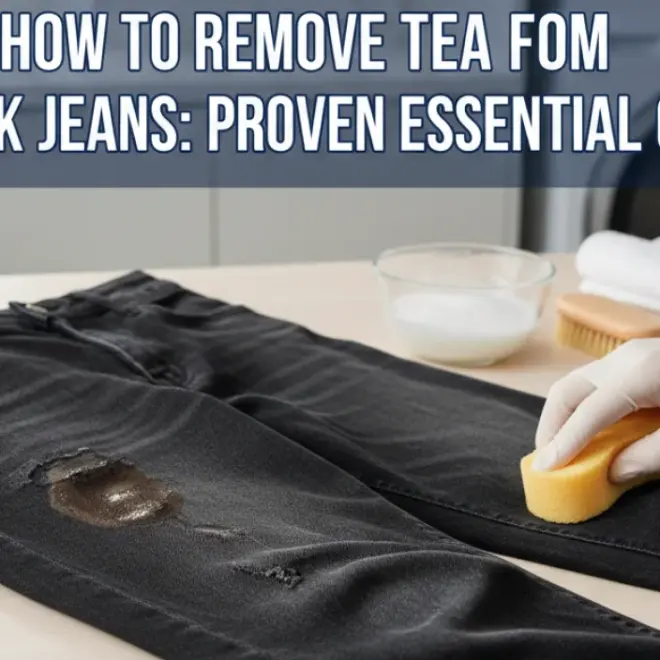Quick Summary: Easily lift curry stains from light wash jeans using household items like dish soap, baking soda, and lemon juice. Act fast, pre-treat, and wash gently for best results, saving your favorite denim.
Curry Removal: Essential Guide For Light Wash Jeans
Oh no, curry! That delicious, vibrant sauce can be a true test for your favorite light wash jeans. Spills happen, and while the thought of a stubborn stain might make you panic, don’t worry. Tackling curry marks on light denim is totally doable with the right approach. This guide will walk you through simple, effective methods that use common household items, helping you restore your jeans to their former glory.
We’ll cover how to act quickly, what ingredients work best, and the gentle techniques needed to lift those stubborn yellow and orange hues without damaging your beloved jeans. Get ready to say goodbye to those curry stains and hello to clean, fresh denim!
Why Curry Stains on Light Wash Jeans Are Tricky
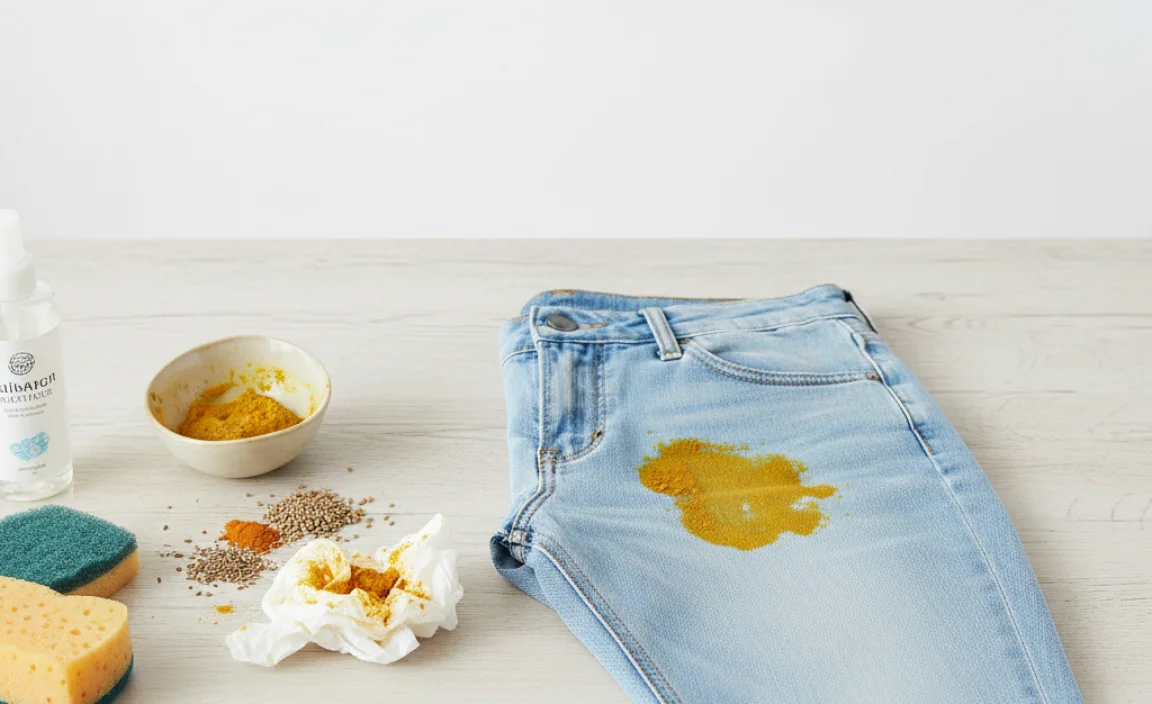
Curry, especially those made with turmeric, is notorious for its potent, staining colors. Turmeric contains curcumin, a natural pigment that’s a powerful chromophore, meaning it absorbs and reflects light in a way that creates intense color. Light wash jeans, with their pale hues, offer very little pigment of their own to compete, making any stain all the more visible.
Furthermore, the oils often present in curry can help the stain to penetrate the fabric fibers more deeply. This combination of potent pigment and oil can make curry stains seem almost impossible to remove, particularly from delicate or lighter fabrics. But with a strategic, gentle approach, these challenges can be overcome.
When to Tackle the Stain: The Sooner, The Better
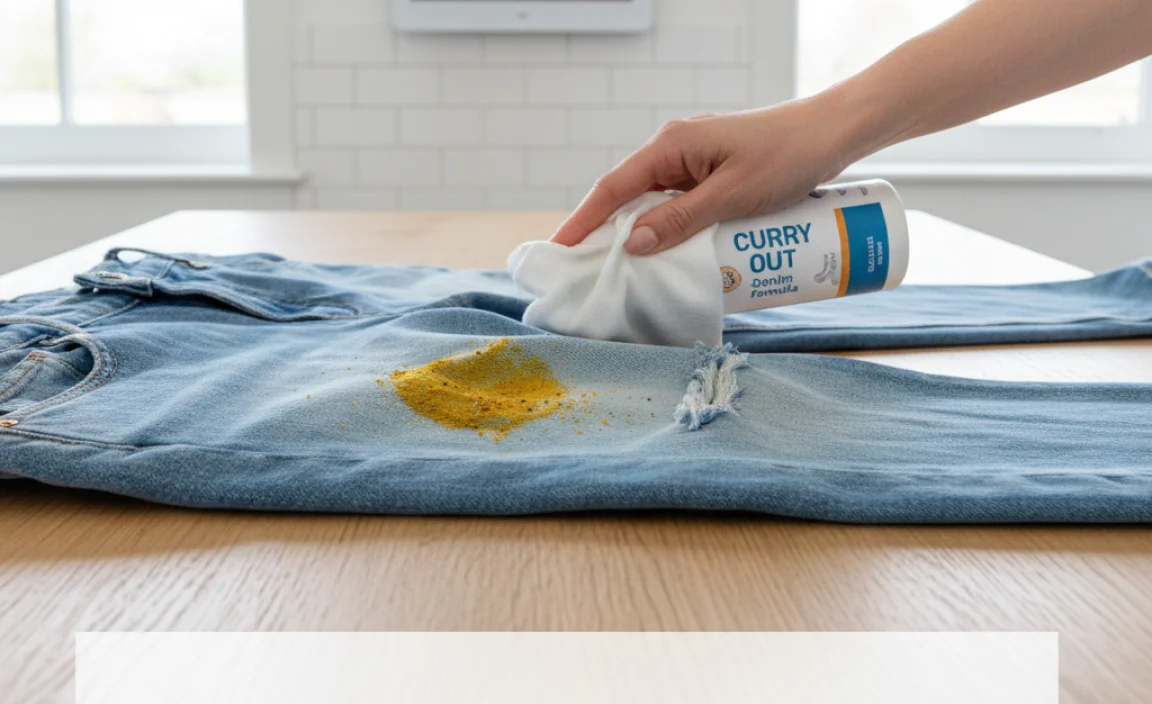
The golden rule for stain removal is immediacy. The longer a curry stain sits on your light wash jeans, the deeper it will set into the fabric, making it significantly harder to remove. Fresh stains are like a temporary visitor; they haven’t had time to unpack their bags and make themselves at home in the denim fibers. Old, dried-in stains are like a permanent resident that’s redecorated and is much harder to evict.
If you notice a spill immediately, here’s your first line of action:
- Gently blot (don’t rub!) excess curry with a clean, dry cloth or paper towel. This removes as much of the surface stain as possible without spreading it.
- Avoid hot water at this stage, as it can sometimes set protein-based stains or make dye stains more difficult to lift.
Essential Tools & Ingredients for Curry Stain Removal

You likely have most of these items already in your home. They’re effective yet gentle enough for your favorite denim.
What You’ll Need:
- Gentle liquid dish soap (like Dawn or similar)
- Baking soda
- White vinegar
- Lemon juice (freshly squeezed is best)
- A clean, soft cloth or old toothbrush
- Paper towels
- A small bowl
- Your regular laundry detergent
- Optional: An oxygen-based stain remover (follow product instructions)
Step-by-Step Guide to Removing Curry Stains
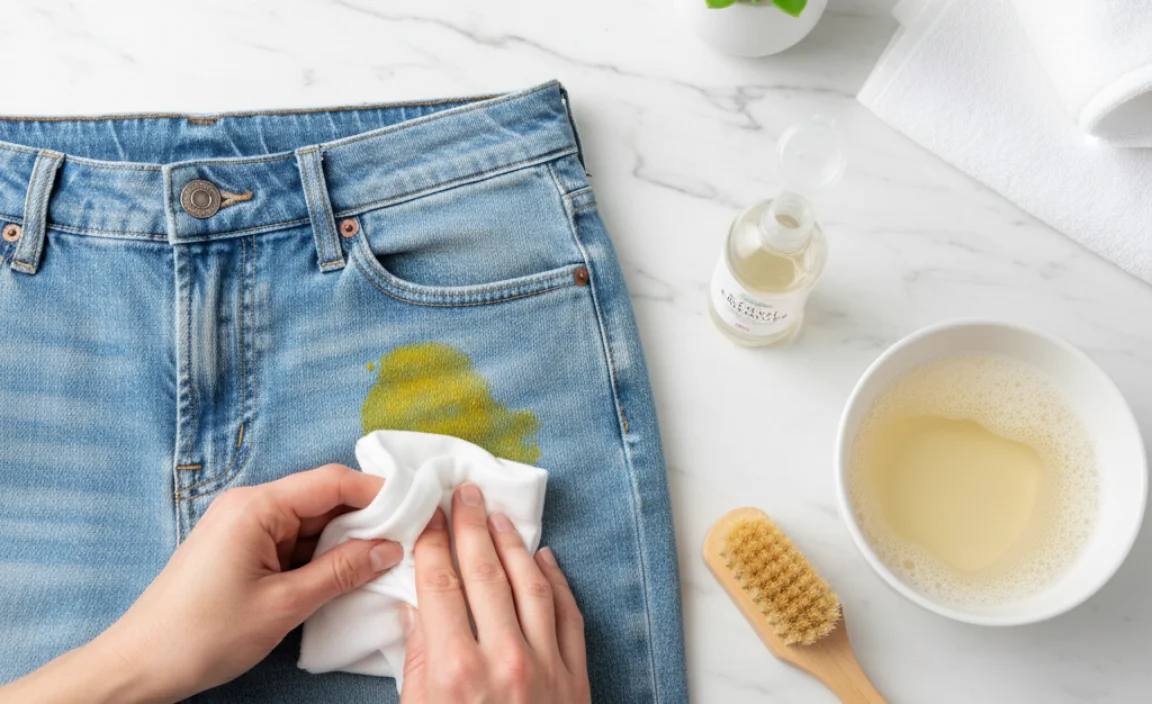
Let’s get those jeans clean! Remember to always test any treatment on an inconspicuous area of your jeans first (like an inside seam) to ensure it doesn’t affect the color or fabric.
Step 1: Immediate Blotting
As soon as the spill happens, take a clean paper towel or a soft cloth and gently dab the stained area. Press down to absorb as much of the excess curry as you can. Do not rub, as this will only spread the stain and push it deeper into the fabric.
Step 2: Pre-Treat with Dish Soap
Dish soap is excellent at breaking down grease and oils, which are often present in curry. Apply a small amount of gentle liquid dish soap directly onto the stain. Use your fingers or a soft cloth to gently work it into the fabric. Let it sit for about 10-15 minutes. You can also use an old, soft toothbrush to gently work the soap in, being careful not to scrub too hard.
Step 3: Create a Baking Soda Paste
Baking soda is a mild abrasive and a natural whitener, making it perfect for lifting stains from light fabrics.
In a small bowl, mix baking soda with a little water to create a thick paste. The consistency should be similar to toothpaste.
Apply this paste generously over the dish soap-treated stain. Ensure the paste covers the entire stained area.
Let the paste dry completely. This can take a few hours. As it dries, it will help to lift the stain out of the denim fibers.
Step 4: Rinse and Assess
Once the baking soda paste is dry, gently brush it off. You can use a soft brush or simply shake the jeans. Rinse the treated area with cool water. Check the stain. If it’s still visible, don’t worry – we have more options.
Step 5: The Lemon Juice Method (for Tougher Stains)
Lemon juice is a natural bleaching agent due to its citric acid content. This method works best in sunlight, which enhances its bleaching power.
If the stain persists after Step 4, pour some fresh lemon juice directly onto the remaining stain.
If you can, lay the jeans out in direct sunlight. The sun’s rays, combined with the lemon juice, can work wonders.
Let the jeans dry in the sun for a few hours. Keep an eye on the stain and reapply lemon juice if needed.
Once the stain appears to be gone or significantly faded, rinse the area thoroughly with cool water.
Important Note: Lemon juice can have a mild bleaching effect, so while it’s great for light washes, be cautious and monitor the process closely to avoid unintentionally lightening parts of your jeans that weren’t stained.
Step 6: The Vinegar Soak (Alternative Pre-Treatment)
White vinegar is another mild acid that can help break down curry stains.
Mix one part white vinegar with two parts cool water.
Soak the stained portion of the jeans in this solution for about 30 minutes.
After soaking, gently blot the stain again and proceed to washing.
Step 7: Wash as Usual (with an Extra Boost)
After pre-treating, it’s time to wash your jeans.
Wash your light wash jeans using your regular laundry detergent.
To give your wash an extra stain-fighting boost, you can add a scoop of an oxygen-based stain remover (like OxiClean or a similar brand) to the wash cycle, following the product’s instructions. Oxygen cleaners are generally safe for colors and help to lift stubborn stains.
Wash on a normal cycle with cool or lukewarm water. Avoid hot water, as it can set any remaining stain.
Step 8: Air Dry and Inspect
This is a crucial step. After washing, inspect the stained area carefully while the jeans are still wet. If any trace of the curry stain remains, do NOT put the jeans in the dryer. Heat from the dryer will permanently set the stain.
Instead, air dry your jeans. Lay them flat or hang them up. Once dry, inspect the area again in good light. If the stain is still visible, repeat the pre-treatment steps (starting again with dish soap and then perhaps trying a different method like the lemon juice or a commercial stain remover). It might take a couple of rounds, but patience is key.
When to Consider Professional Help
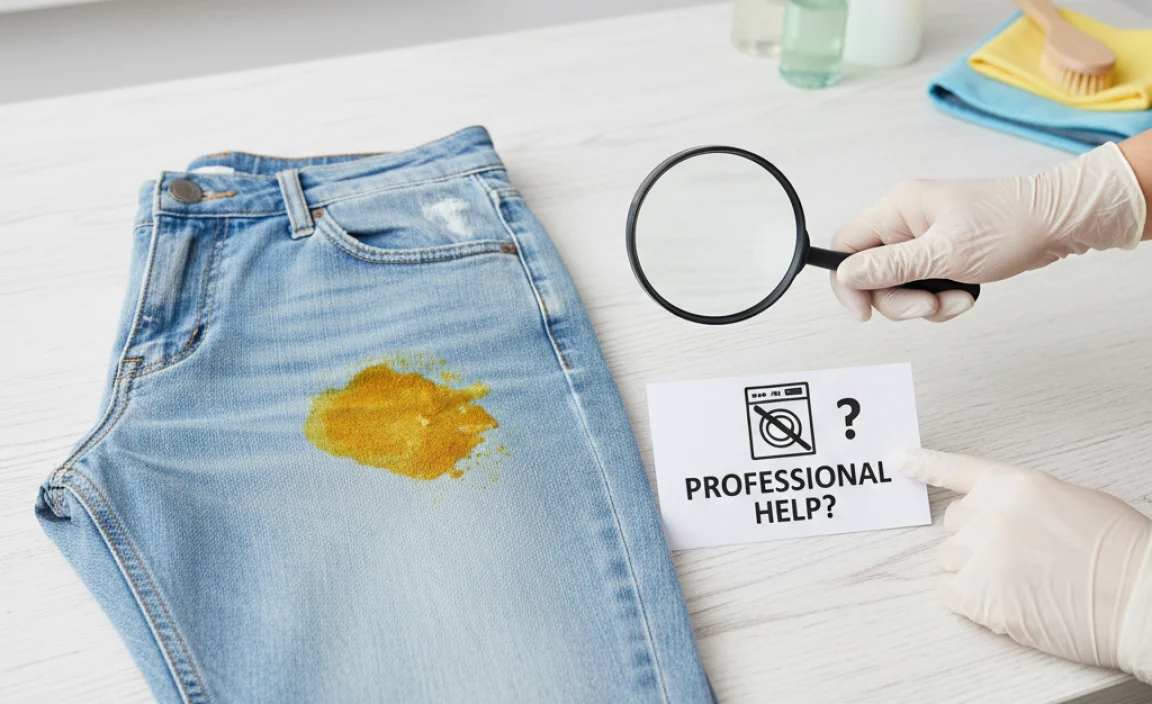
For extremely stubborn stains, or if you’re dealing with very delicate or expensive light wash jeans, you might consider consulting a professional dry cleaner. They have access to specialized solvents and techniques that can tackle difficult stains without damaging the fabric. When dropping them off, be sure to point out the exact location and nature of the stain.
Understanding Common Stain Removal Ingredients
Here’s a quick look at why these common household items are so effective:
| Ingredient | How it Works | Best For |
|---|---|---|
| Liquid Dish Soap | Breaks down oils and grease, lifting the stain from fibers. | Initial pre-treatment, especially for oil-based components of curry. |
| Baking Soda | Mild abrasive and natural whitener; paste helps lift stains out. | Absorbing and lifting stains, gentle whitening effect. |
| Lemon Juice | Natural mild bleach (citric acid); enhanced by sunlight. | Fading stubborn color pigments like turmeric. |
| White Vinegar | Mild acidic properties help break down and lift certain dyes. | Soaking tough stains before washing. |
| Oxygen-Based Stain Remover | Releases oxygen in water to lift and break down colored stains safely. | Boosting regular laundry cycles for comprehensive stain removal. |
For more information on fabric care and stain removal, resources like the Federal Trade Commission (FTC) offer general advice on tackling common household laundry issues.
Caring for Your Light Wash Jeans After Stain Removal
Once your light wash jeans are stain-free and clean, it’s a good idea to maintain their pristine condition. Treat them gently during future washes.
- Wash light wash jeans separately or with other light-colored items to prevent color transfer.
- Use a gentle cycle and cool water whenever possible.
- Avoid using bleach unless absolutely necessary and specifically indicated as safe for your denim. Bleach can weaken fibers and alter the color.
- Tumble dry on low heat or, preferably, air dry to minimize shrinkage and fabric stress.
Frequently Asked Questions About Curry Stains on Jeans
Q1: Will turmeric stain set permanently if I use hot water?
A: Yes, hot water can often set turmeric and other pigment-based stains permanently into fabric fibers. Always use cool or lukewarm water when initially treating and washing curry-stained items.
Q2: Can I use a regular bleach pen on curry stains?
A: It’s generally not recommended to use chlorine bleach on light wash jeans unless you are trying to achieve a distressed look or the care label specifically allows it. Chlorine bleach can weaken denim fibers and create uneven, harsh bleaching. Opt for safer, color-safe alternatives like oxygen-based removers or lemon juice.
Q3: How long should I leave a stain treatment on my jeans?
A: For pre-treatments like dish soap, 10-15 minutes is usually sufficient. For pastes like baking soda, letting it dry completely (which can take a few hours) is beneficial. Lemon juice treatments might require several hours in the sun. Always follow specific product instructions for commercial removers.
Q4: My jeans still have a faint yellow tint after washing. What now?
A: A faint tint often means the stain hasn’t been fully lifted. Repeat the pre-treatment process, perhaps trying the lemon juice and sun method if you haven’t already. Wash again, ensuring you air dry and inspect thoroughly before drying with heat.
Q5: Can these methods damage the color of my light wash jeans?
A: While these methods are generally gentle, always test on an inconspicuous area first. Lemon juice and prolonged sun exposure can have a slight lightening effect. If your jeans have a specific or uneven dye, test with extreme care.
Q6: What if the curry stain is old and dried?
A: Old, dried stains are tougher but not impossible. You’ll likely need to pre-soak the area for a longer period, possibly overnight, using a mild detergent or an oxygen-based cleaner solution. Then, follow with the pre-treatment steps as usual. Multiple treatments might be necessary.
Conclusion
Dealing with curry stains on your light wash jeans might seem daunting, but as we’ve shown, it’s a manageable task. By acting swiftly, employing gentle yet effective household remedies like dish soap, baking soda, and lemon juice, and always air-drying to check your progress, you can successfully rescue your denim.
Remember that patience is key. Some stubborn stains may require a couple of treatment cycles. Always test treatments on a hidden area, and prioritize the longevity of your jeans by avoiding harsh chemicals and high heat. With these practical steps, you can confidently tackle curry spills and keep your light wash jeans looking fresh and clean for any occasion.








